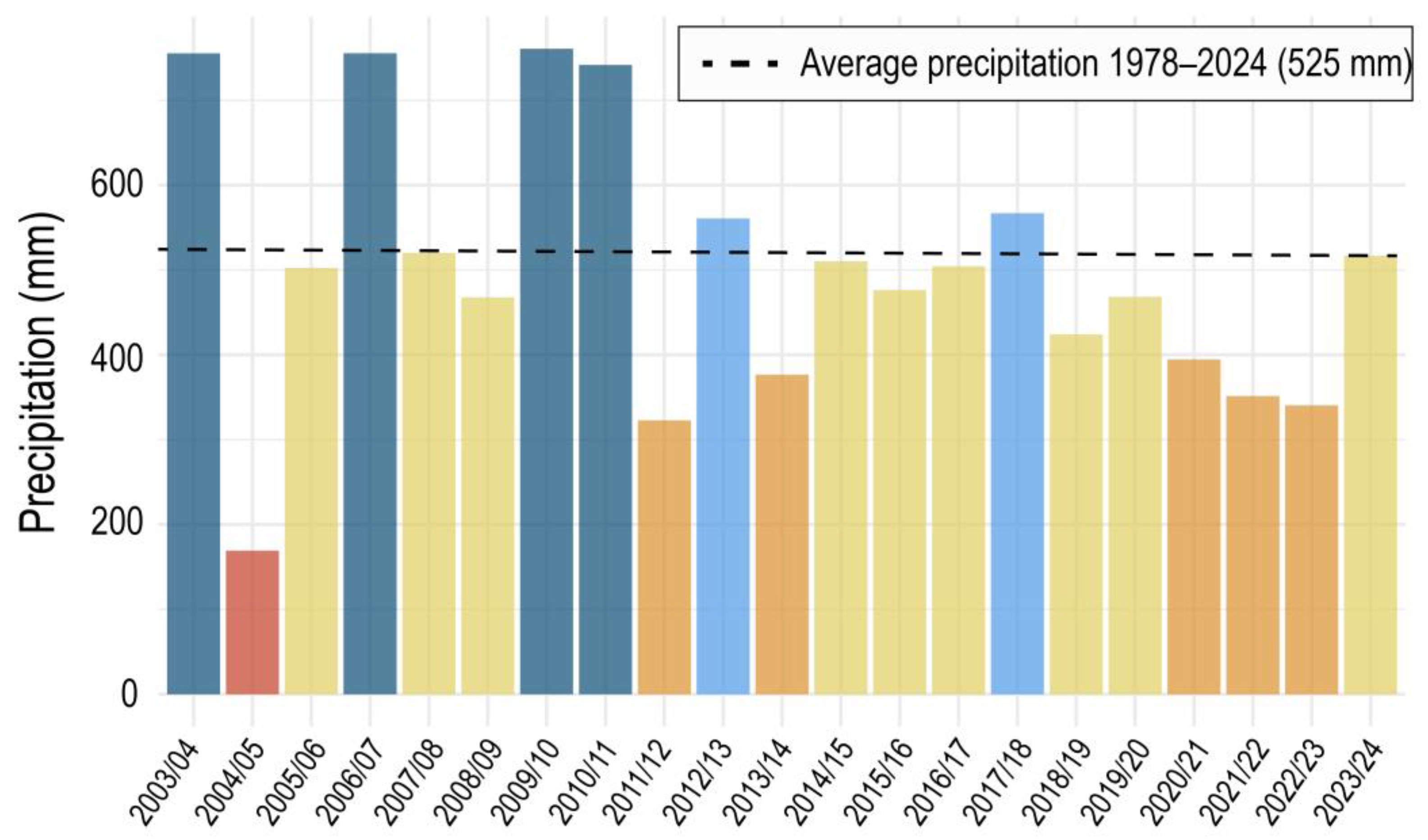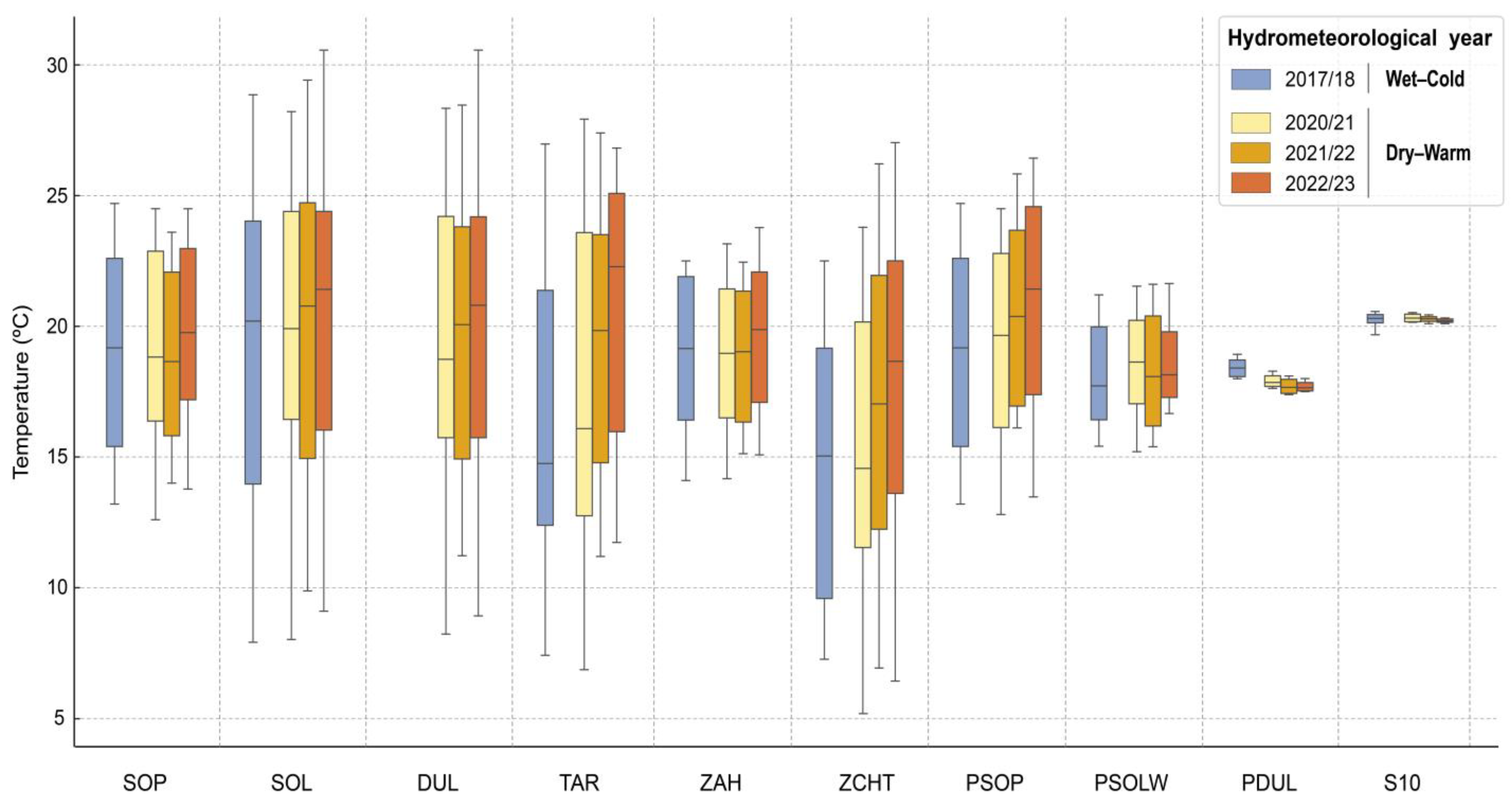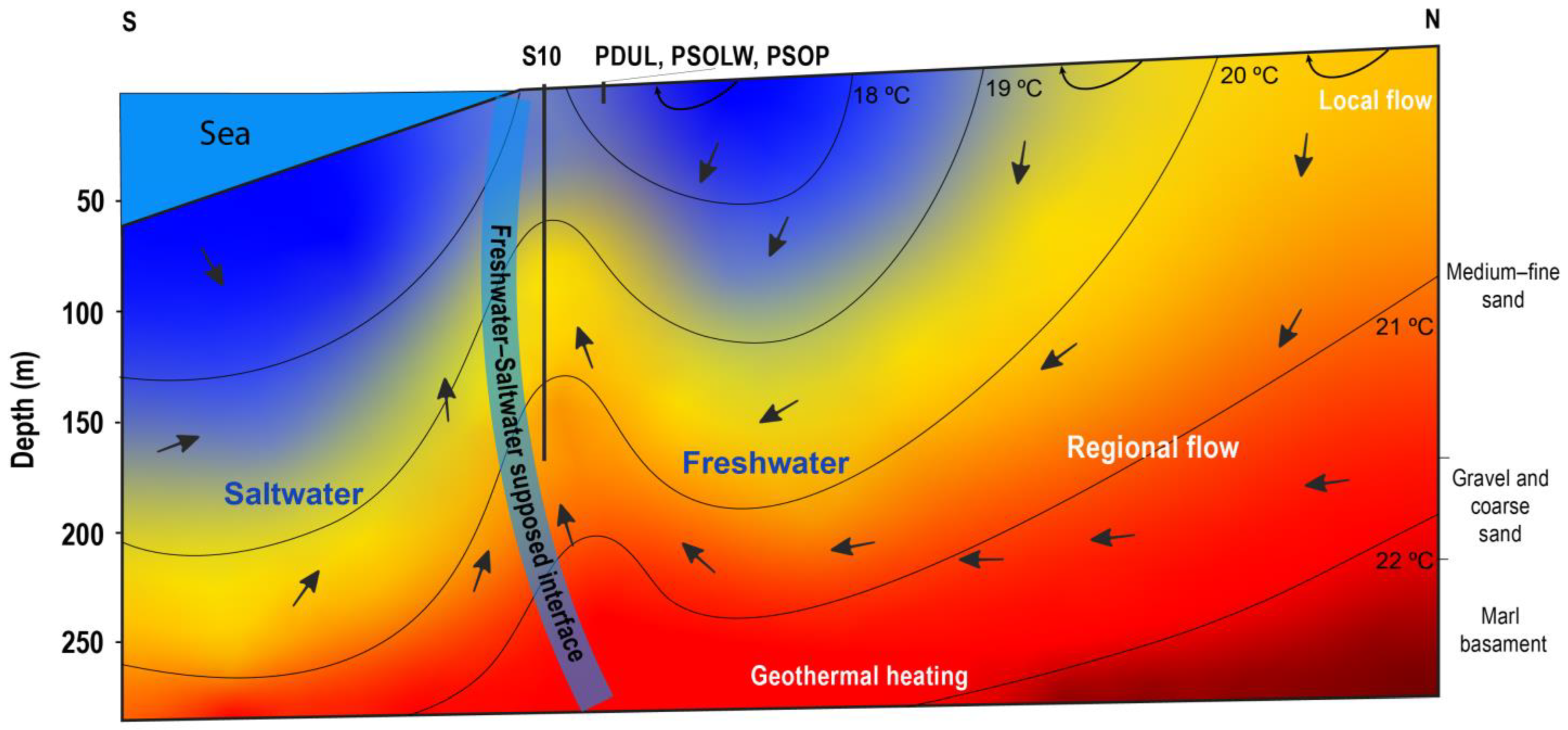Groundwater/Surface Water Temperature Variations and Hydrogeological Implications in Doñana National Park
Abstract
1. Introduction
2. Study Zone and Hydrogeological Characteristics of the Almonte-Marismas Aquifer
3. Material and Methods
4. Results
4.1. Climate Setting
4.2. Thermal Regime of Surface and Subsurface Waters
4.3. Thermal Regime of Groundwater
4.4. Water Temperature Trend
5. Discussion
5.1. Surface Water and Shallow Groundwater Temperature
5.2. Deep Groundwater Temperature
6. Conclusions
Author Contributions
Funding
Data Availability Statement
Acknowledgments
Conflicts of Interest
References
- Zorrilla-Miras, P.; Palomo, I.; Gomez-Baggethun, E.; Martín-López, B.; Lomas, P.L.; Montes, C. Effects of land-use change on wetland ecosystem services: A case study in the Doñana marshes (SW Spain). Landsc. Urban Plan. 2014, 122, 160–174. [Google Scholar] [CrossRef]
- Green, A.J.; Guardiola-Albert, C.; Bravo-Utrera, M.A.; Bustamante, J.; Camacho, A.; Caro, J.; Casado, A.; González-Arbáez, E.; Espinar, J.L.; Teles da Gama, F.; et al. Groundwater abstraction has caused extensive ecological damage to the Doñana World Heritage Site, Spain. Wetlands 2024, 44, 20. [Google Scholar] [CrossRef]
- De Felipe, M.; Amat, J.A.; Arroyo, J.L.; Rodríguez, R.; Díaz-Paniagua, C. Habitat changes at the local scale have major impacts on waterfowl populations across a migratory flyway. Glob. Change Biol. 2024, 30, e17600. [Google Scholar] [CrossRef]
- Rodríguez-Rodríguez, M.; Aguilera, H.; Guardiola-Albert, C.; Fernández-Ayuso, A. Climate influence vs. anthropogenic drivers in surface water-groundwater interactions in eight ponds of Doñana Natural Area (southern Spain). Wetlands 2021, 41, 25. [Google Scholar] [CrossRef]
- García-Bravo, N.; Guardiola-Albert, C. Upgrading aquifer test interpretations with numerical axisymmetric flow models using MODFLOW in the Doñana area (Spain). Boletín Geológico Min. 2012, 123, 41–54. [Google Scholar]
- Green, A.J.; Bustamante, J.; Janss, G.F.E.; Fernández-Zamudio, R.; Díaz-Paniagua, C. Doñana Wetlands (Spain). In The Wetland Book; Finlayson, C., Milton, G., Prentice, R., Davidson, N., Eds.; Springer: Dordrecht, The Netherlands, 2018; pp. 1–10. [Google Scholar] [CrossRef]
- Manzano, M.; Custodio, E.; Iglesias, M.; Soler, A. Groundwater resources and ecological impacts in Doñana National Park. Hydrol. Process. 2001, 15, 1431–1450. [Google Scholar] [CrossRef]
- Díaz-Paniagua, C.; Fernández-Zamudio, R.; Green, A.J.; Bustamante, J. The impacts of climate variability on temporary ponds in Doñana National Park. Wetl. Res. Lett. 2024, 12, 56–70. [Google Scholar]
- De Felipe, M.; Aragonés, D.; Díaz-Paniagua, C. Thirty-four years of Landsat monitoring reveal long-term effects of groundwater abstractions on a World Heritage Site wetland. Sci. Total Environ. 2023, 880, 163329. [Google Scholar] [CrossRef]
- Rodriguez-Rodriguez, M.; Fernández-Ayuso, A.; Hayashi, M.; Moral-Martos, F. Using Water Temperature, Electrical Conductivity, and pH to Characterize Surface–Groundwater Relations in a Shallow Ponds System (Doñana National Park, SW Spain). Water 2018, 10, 1415. [Google Scholar] [CrossRef]
- Fernández-Ayuso, A.; Rodríguez-Rodríguez, M.; Benavente, J. Assessment of the hydrological status of Doñana dune ponds: A natural World Heritage Site under threat. Hydrol. Sci. J. 2018, 63, 2048–2059. [Google Scholar] [CrossRef]
- Fernández-Ayuso, A.; Aguilera, H.; Guardiola-Albert, C.; Rodríguez-Rodríguez, M.; Heredia, J.; Naranjo-Fernández, N. Unraveling the hydrological behavior of a coastal pond in Doñana National Park (Southwest Spain). Ground Water 2019, 57, 895–906. [Google Scholar] [CrossRef]
- Treviño, J.; Rodríguez-Rodríguez, M.; Montes-Vega, M.J.; Aguilera, H.; Fernández-Ayuso, A.; Fernández-Naranjo, N. Wavelet Analysis on Groundwater, Surface-Water Levels andWater Temperature in Doñana National Park (Coastal Aquifer in Southwestern Spain). Water 2023, 15, 796. [Google Scholar] [CrossRef]
- Dimitriou, E.; Mousoulis, E.; Díaz-Paniagua, C.; Serrano, L. Hydrodynamic numerical modelling of the water level decline in four temporary ponds of the Doñana National Park (SW Spain). J. Arid. Environ. 2017, 147, 92–100. [Google Scholar] [CrossRef]
- Kuryluk, B.L.; Irvine, D.J.; Bense, V.F. Theory, tools, and multidisciplinary applications for tracing groundwater fluxes from temperature profiles. Water 2018, 5, e1299. [Google Scholar] [CrossRef]
- Custodio, E.; Manzano, M.; Iglesias, M. Análisis térmico preliminar de los acuíferos de Doñana. IV SIAGA 1996, II, 57–87. [Google Scholar]
- Tamburini, A.; Menichetti, M. Groundwater temperature as a natural tracer to characterize hydraulic behaviour and geometry of carbonate aquifers: Mt. Nerone karst system, central Italy. Rend. Online Soc. Geol. Ital. 2019, 47, 121–125. [Google Scholar] [CrossRef]
- Gruszczyński, T.; Szostakiewicz-Hołownia, M.; Zaszewski, D. Interpretation of spring-water temperature variability based on continuous monitoring and numerical modelling of heat transport and water mixing: Case study of Czarny Potok spring, Pieniny Mountains, southern Poland. Hydrogeol. J. 2023, 31, 1–12. [Google Scholar] [CrossRef]
- Blanco-Coronas, A.M.; Duque, C.; Calvache, M.L.; López-Chicano, M. Temperature distribution in coastal aquifers: Insights from groundwater modeling and field data. J. Hydrol. 2021, 603, 126912. [Google Scholar] [CrossRef]
- Blanco-Coronas, A.M.; Calvache, M.L.; López-Chicano, M.; Martín-Montañés, C.; Jiménez-Sánchez, J.; Duque, C. Salinity and temperature variations near the freshwater-saltwater interface in coastal aquifers induced by ocean tides and changes in recharge. Water 2022, 14, 2807. [Google Scholar] [CrossRef]
- Guardiola-Albert, C.; Jackson, C.R. Potential impacts of climate change on groundwater supplies to the Doñana wetland, Spain. Wetlands 2011, 31, 907–920. [Google Scholar] [CrossRef]
- Naranjo-Fernández, N.; Guardiola-Albert, C.; Montero, E. Applying 3D geostatistical simulation to improve the groundwater management modelling of sedimentary aquifers: The case of Doñana (Southwest Spain). Water 2018, 11, 39. [Google Scholar] [CrossRef]
- Blanco Coronas, Á.M. Coastal Aquifers and Processes Related to Global Change: Wetlands, Heat Transport and Floodings. Ph.D. Thesis, Universidad de Granada, Granada, Spain, 2023. Available online: https://hdl.handle.net/10481/82172 (accessed on 17 February 2025).
- Jiménez-Bonilla, A.; Rodríguez-Rodríguez, M.; Yanes, J.L.; Gázquez, F. Impact of climate change on permanent lakes in a semiarid region: Southwestern Mediterranean basin (S Spain). Sci. Total Environ. 2025, 961, 178305. [Google Scholar] [CrossRef] [PubMed]
- Erostate, M.; Huneau, F.; Garel, E.; Ghiotti, S.; Vystavna, Y.; Garrido, M.; Pasqualini, V. Groundwater dependent ecosystems in coastal Mediterranean regions: Characterization, challenges and management for their protection. Water Res. 2020, 172, 115461. [Google Scholar] [CrossRef]
- Montes-Vega, M.J.; Guardiola-Albert, C.; Rodríguez-Rodríguez, M. Calculation of the SPI, SPEI, and GRDI Indices for Historical Climatic Data from Doñana National Park: Forecasting Climatic Series (2030–2059) Using Two Climatic Scenarios RCP 4.5 and RCP 8.5 by IPCC. Water 2023, 15, 2369. [Google Scholar] [CrossRef]
- Naranjo-Fernández, N.; Guardiola-Albert, C.; Aguilera, H.; Serrano-Hidalgo, C.; Rodríguez-Rodríguez, M.; Fernández-Ayuso, A.; Ruiz-Bermudo, F.; Montero-González, E. Relevance of spatio-temporal rainfall variability regarding groundwater management challenges under global change: Case study in Doñana (SW Spain). Stoch. Environ. Res. Risk Assess. 2020, 34, 1289–1311. [Google Scholar] [CrossRef]
- Salvany, J.M.; Custodio, E. Características litoestratigráficas de los depósitos plio-cuaternarios del entorno de Doñana: Implicaciones hidrogeológicas. Rev. Soc. Geol. Esp. 1995, 8, 2–31. [Google Scholar]
- Custodio, E.; Manzano, M.; Montes, C. Las aguas subterráneas en Doñana. In Aspectos Ecológicos y Sociales; Junta de Andalucía: Sevilla, Spain, 2009; p. 243. [Google Scholar]
- Instituto Geológico y Minero de España. Encomienda de Gestión para la Realización de Trabajos Científico-Técnicos de Apoyo a la Sostenibilidad y Protección de las Aguas Subterráneas: Demarcación Hidrográfica 051 Guadalquivir, Masa de Agua Subterránea 051.051 Almonte-Marismas del Guadalquivir; Ministerio de Ciencia e Innovación, Ministerio de Medio Ambiente y Medio Rural y Marino, Dirección General del Agua: Madrid, Spain, 2024.
- Yanes, J.L.; Rodríguez-Rodríguez, M.; Montes-Vega, M.J.; Jiménez-Bonilla, A.; Moral, F. Monitorización hidrológica de las lagunas peridunares de los mantos eólicos de Doñana en el periodo 2020–2023. Geogaceta 2024, 76, 55–58. [Google Scholar] [CrossRef]
- R Core Team. R: A Language and Environment for Statistical Computing; R Foundation for Statistical Computing: Vienna, Austria, 2024; Available online: https://www.R-project.org/ (accessed on 17 September 2024).
- Martinsen, K.T.; Andersen, M.R.; Sand-Jensen, K. Water temperature dynamics and the prevalence of daytime stratification in small temperate shallow lakes. Hydrobiologia 2018, 830, 87–103. [Google Scholar] [CrossRef]
- Woolway, R.I.; Jennings, E.; Shatwell, T.; Golub, M.; Pierson, D.C.; Maberly, S.C. Lake heatwaves under climate change. Nature 2021, 589, 402–407. [Google Scholar] [CrossRef]
- Christensen, J.P.A.; Sand-Jensen, K.; Staehr, P.A. Fluctuating water levels control water chemistry and metabolism of a charophyte-dominated pond. Freshw. Biol. 2013, 58, 1353–1365. [Google Scholar] [CrossRef]
- Holgerson, M.A.; Richardson, D.C.; Roith, J.; Bortolotti, L.E.; Finlay, K.; Hornbach, D.J.; Gurung, K.; Ness, A.; Andersen, M.R.; Bansal, S.; et al. Classifying mixing regimes in ponds and shallow lakes. Water Resour. Res. 2022, 58, e2022WR032522. [Google Scholar] [CrossRef]
- Yvon-Durocher, G.; Caffrey, J.M.; Cescatti, A.; Dossena, M.; Giorgio, P.D.; Gasol, J.M.; Montoya, J.M.; Pumpanen, J.; Staehr, P.A.; Trimmer, M.; et al. Reconciling the temperature dependence of respiration across timescales and ecosystem types. Nature 2012, 487, 472–476. [Google Scholar] [CrossRef] [PubMed]
- Andersen, M.R.; Sand-Jensen, K.; Woolway, R.I.; Jones, I.D. Profound daily vertical temperature variation and mixing in a small, shallow, wind-exposed lake with submerged macrophytes. Aquat. Sci. 2017, 79, 395–405. [Google Scholar] [CrossRef]
- Keery, J.; Binley, A.; Crook, N.; Smith, J.W.N. Temporal and spatial variability of groundwater–surface water fluxes: Development and application of an analytical method using temperature time series. J. Hydrol. 2007, 336, 1–16. [Google Scholar] [CrossRef]
- Montes-Vega, M.J.; Rodríguez-Rodríguez, M. Análisis del hidroperiodo de tres lagunas de la Reserva Biológica de Doñana (2018–2020). Geogaceta 2021, 70, 43–46. [Google Scholar] [CrossRef]
- Acreman, M.; Casier, R.; Salathé, T. Evidence-based risk assessment of ecological damage due to groundwater abstraction: The case of Doñana Natural Space, Spain. Wetlands 2022, 42, 63. [Google Scholar] [CrossRef]









| Monitoring Point | UTM X | UTM Y | Altitude (m a.s.l.) | Depth * (m) | Average Flooded Area (m2) | ||
|---|---|---|---|---|---|---|---|
| Wet Periods | Dry Periods | ||||||
| PONDS | SOP | 192,853 | 4,095,825 | 2.10 | 0.98 | 28,750 | 12,448 |
| SOL | 190,342 | 4,098,107 | 4.60 | 1.20 | 269,410 | 97,852 | |
| DUL | 189,871 | 4,098,395 | 5.10 | 1.32 | 74,941 | 14,710 | |
| TAR | 188,694 | 4,099,221 | 7.50 | 0.80 | 106,998 | 2908 | |
| ZAH | 187,886 | 4,099,189 | 6.50 | 0.53 | 46,015 | 1706 | |
| PIEZOMETERS | ZCHT * | 187,525 | 4,099,661 | 10.6 | 1.85 | 84 | 84 |
| PSOP | 193,141 | 4,095,961 | 2.45 | 2 | |||
| PSOLW | 190,142 | 4,098,479 | 5.80 | 20 | |||
| PDUL | 190,037 | 4,098,486 | 5.75 | 20 | |||
| S10 | 186,478 | 4,097,170 | 17.45 | 170 | |||
| n | Mean | SD | Min | 25% | 50% | 75% | Max | |
|---|---|---|---|---|---|---|---|---|
| Surface and subsurface water | ||||||||
| SOP | 2922 | 19.29 | 3.59 | 12.25 | 16.02 | 19.28 | 22.80 | 25.56 |
| SOL | 2922 | 19.85 | 5.29 | 7.91 | 15.36 | 20.32 | 24.51 | 30.57 |
| DUL | 1461 | 19.80 | 5.05 | 8.23 | 15.41 | 19.86 | 24.16 | 30.76 |
| TAR | 2922 | 18.29 | 5.53 | 6.09 | 13.65 | 17.58 | 23.67 | 27.93 |
| ZAH | 2922 | 19.22 | 2.74 | 14.10 | 16.75 | 19.28 | 21.80 | 24.69 |
| ZCHT | 2098 | 16.75 | 5.27 | 5.20 | 12.48 | 16.48 | 21.63 | 27.03 |
| Groundwater | ||||||||
| PSOP | 2922 | 19.79 | 3.71 | 12.25 | 16.42 | 19.83 | 23.30 | 26.43 |
| PSOLW | 2922 | 18.44 | 1.81 | 15.20 | 16.92 | 18.27 | 20.12 | 21.64 |
| PDUL | 2922 | 18.04 | 0.39 | 17.39 | 17.73 | 18.00 | 18.30 | 18.97 |
| S10 | 1453 | 20.26 | 0.16 | 19.56 | 20.17 | 20.27 | 20.37 | 20.57 |
| Air | 2920 | 18.05 | 5.83 | 4.80 | 13.20 | 17.80 | 22.70 | 35.50 |
Disclaimer/Publisher’s Note: The statements, opinions and data contained in all publications are solely those of the individual author(s) and contributor(s) and not of MDPI and/or the editor(s). MDPI and/or the editor(s) disclaim responsibility for any injury to people or property resulting from any ideas, methods, instructions or products referred to in the content. |
© 2025 by the authors. Licensee MDPI, Basel, Switzerland. This article is an open access article distributed under the terms and conditions of the Creative Commons Attribution (CC BY) license (https://creativecommons.org/licenses/by/4.0/).
Share and Cite
Yanes, J.L.; Jiménez-Bonilla, A.; Martínez-Caro, M.; Fernández-Ayuso, A.; Rodríguez-Rodríguez, M. Groundwater/Surface Water Temperature Variations and Hydrogeological Implications in Doñana National Park. Environments 2025, 12, 83. https://doi.org/10.3390/environments12030083
Yanes JL, Jiménez-Bonilla A, Martínez-Caro M, Fernández-Ayuso A, Rodríguez-Rodríguez M. Groundwater/Surface Water Temperature Variations and Hydrogeological Implications in Doñana National Park. Environments. 2025; 12(3):83. https://doi.org/10.3390/environments12030083
Chicago/Turabian StyleYanes, José Luis, Alejandro Jiménez-Bonilla, Marina Martínez-Caro, Ana Fernández-Ayuso, and Miguel Rodríguez-Rodríguez. 2025. "Groundwater/Surface Water Temperature Variations and Hydrogeological Implications in Doñana National Park" Environments 12, no. 3: 83. https://doi.org/10.3390/environments12030083
APA StyleYanes, J. L., Jiménez-Bonilla, A., Martínez-Caro, M., Fernández-Ayuso, A., & Rodríguez-Rodríguez, M. (2025). Groundwater/Surface Water Temperature Variations and Hydrogeological Implications in Doñana National Park. Environments, 12(3), 83. https://doi.org/10.3390/environments12030083






